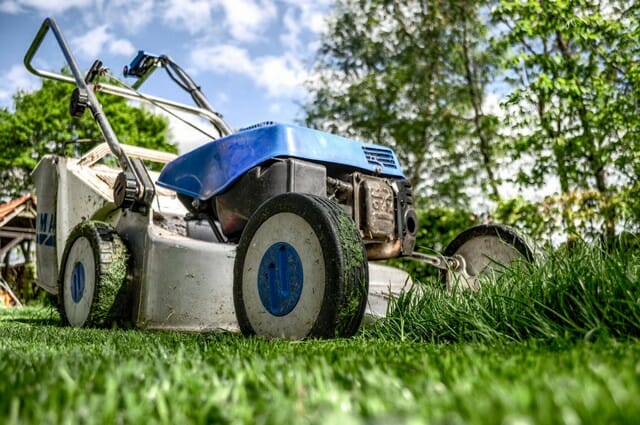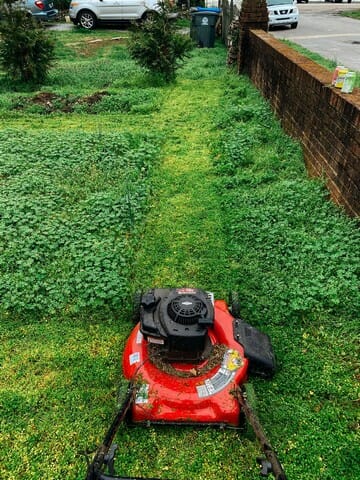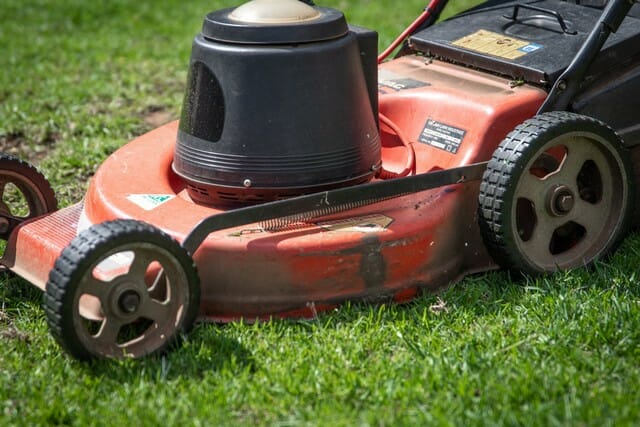Last Updated on November 10, 2021 by Grow with Bovees

The smell of fresh-cut grass is a joy for everyone who enjoys a little gardening. And the one way to definitely destroy that experience is to have your lawnmower die right after you start it.
There can be many reasons for your mower to sputter out mere seconds after it starts. And the good news is that there are a few obvious suspects and we will tell you what to do if you get into any of those situations so that you can fix it and mow away to glory. Let’s dive right in.
Causes for Lawn Mower Starting Then Dying
The problem of lawnmowers dying right after they start is more common than you’d think. And that’s not bad news because it means that it is easy for you to find solutions and get on with your gardening. We’ve listed the top six reasons and we’ll tell you how to fix each of them right now.
Old Gas That Formed Residues Causes and How to Fix It
If you don’t use your lawnmower for a long time, the gas in the engine tends to evaporate. However, it will also leave some residue in the carburetor in the form of particles or gummy residue.
These particles or gummy bits are very capable of clogging the carburetor. When that happens, the blockage interrupts the flow of new gas into the engine. A carburetor makes sure that air and fuel mix well before entering the engine so that combustion takes place.
When you don’t clean it well enough, this disrupts the fuel-to-air ratio inside the carburetor and prevents the mower from doing its job.
The easiest thing to do is to remove the old gas and add a fuel stabilizer before putting in the new fuel. If you have left the lawnmower unused for a long time, you might want to get a carburetor cleaner like the WD-40 and make sure its ports are ready for the new fuel.
If it is a 2 cycle mower, be sure to mix the correct ratio of gas to oil. If your mower is an older model, it may be using a 40 to 1 fuel mix, but many newer models use a 50 to 1 oil mix.
You can also get an entire repair kit if this happens very often. You might also want to check if there is a need to replace components like gaskets, springs and needles in the carburetor.
Dirty or Defective Spark Plug Symptoms and How to Fix It?

If you suspect that the spark plug is the problem, you need to confirm it first. You can use an ignition tester for this job or conduct a test visually. In their sockets, spark plugs sometimes accumulate carbon which makes them inefficient in igniting the air/fuel mix in the engine.
So, if they are not clean, your mower might start and die right away. That is if it starts at all. It is also possible because of a weak electrode.
Spark plugs are placed in front of the mower and are wrapped inside a black cable. Remove it manually with a socket wrench and check them for the carbon coating. Use a wire brush to clean the residue.
Never use a shot-blasting cleaner. But if it looks beyond repair, consider replacing the plug. Check for the size and get a new one. These are pretty cheap.
In any case, you must replace spark plugs every one or two years as part of your regular mower maintenance. If you want to do it yourself, remove the spark plug’s wire hook and take out the existing plug out of its socket.
Use a feeler gauge to measure the space between the two electrodes. Note down the specifications of your model and get the replacement. When you place the new plug, the feeler gauge is expected to drag a little. Just make sure it is not overly tight and you should be fine.
Blocked or Dirty Carburetor Bowl Symptoms and How to Fix It?
It is not unheard of for a lawnmower to act up because of a clogged carburetor. But how do you know that’s the problem? Here are a few telltale signs.
- The engine stalls when you’re working on the lawn
- The engine feels rough when it is moving
- There is black smoke coming out of the muffler
- It consumes too much fuel for regular use
Now, this is usually the case when you leave old fuel in the lawnmower and don’t use it for a long time. We’ve discussed what to do there. But there is more than one way to fix a blocked carburetor. If it is beyond repair, you must consider replacing the whole unit. But, if not, here’s what you do.
If the bowl is clogged, the fuel-to-air ratio will be compromised and without combustion, the lawnmower won’t work. To fix it, start by taking an aerosol can of cleaner (meant for carburetors) and give the bowl a good spray with the carb cleaner.
This is meant to breakdown the carbon particles and clean the surface of your carburetor bowl.
For that, you must remove the bowl from the mower. Remove the screws and clean them along with the hole in the carburetor bowl thoroughly.
If you have a directional sprayer, you are better equipped to clean specific corners. Do the same with the bowl and place it back. Do not over-tighten the screws when you put the bowl back.
How to Check If the Choke Is Not Operating Correctly
A choke that isn’t working properly is another common problem when dealing with a malfunctioning lawnmower. The most common reason is that the system is flooding. This happens if you leave the mower at full choke even if for a few seconds.
A lot of fuel enters the top of the engine, and literally floods the combustion chamber. This prevents the spark plug from being able to produce a spark, so the engine cannot start.
The other reason is that the choke is stuck in the on position, and doesn’t move, which also causes the engine to flood. You must open it completely and let the engine restart properly. If you don’t, you will notice that dirt builds up and the choke gets completely stuck.
When this kind of flooding happens, the engine won’t start at the first pull. That’s your first sign that the choke could be the problem. In these situations, pulling the cord repeatedly might not be the answer.
Instead, what you must do is pull it until it looks like the engine is ready to start. Then move it to half-choke and let some air enter the combustion chamber.
To make sure this goes smoothly, lubricate the shaft and the linkage of the choke. This can be done by spraying the carburetor cleaner or a lubricant such as WD40 along the choke shaft to loosen it.
If the choke isn’t opening or closing well, you must adjust the linkage by loosening its mounting bracket. You can refer to the owner’s manual if you’re not sure. Move the lever and its cable to remove any gaps.
Blocked Gasoline Cap and How to Fix It?

In your fuel cap, there is a small hole that allows air to enter the fuel tank, which allows the gas to flow out of the tank along the fuel line to the carburetor. If this hole is blocked, a vacuum will occur and the gas will not be able to get out of the fuel tank.
Obviously, without any gasoline/air mixture in the combustion chamber, the engine will not run.
This is easy to fix.
Just remove the fuel cap from the gas tank, and make sure that the breather hole is not blocked and that air can pass freely through it.
If you do find it blocked, you can easily clean it with a nozzle cleaner, or a small piece of wire that is thin enough to pass through the hole.
Also, take note of the maximum fuel level mark on the fuel tank, and be sure not to fill the tank past this mark.
The reason for this is that the gas in the tank will expand when it gets warm, and the space in the fuel tank is there to allow for this expansion. If there is too much fuel in the tank, it will start to escape through the breather hole in the cap, which is a fire risk while the engine is running.
Too Much Oil in the Mower Engine and How to Fix It?
To check the oil level inside the engine, the engine needs to be not running. Locate the dipstick or engine oil level sight glass and make sure that it is not above the maximum level.
If you do find that the oil level is too high, then some oil must be removed. To do this you will need to find the oil drain plug, loosen it with the proper size wrench, and let out some oil into a suitable container until the oil is at the right level.
If you have a large lawn tractor or zero turn model, you may need to get underneath to make the oil draining easier. A suitable sized lawn mower lift will make this and any future maintenance much easier and less tiresome to do.
Wrapping Up: Preventing Lawn Mower Engine Problems
The simplest way to prevent these problems is by taking regular care of the mower. Start by reading the manual which tells you the best ways to maintain the machine.
Make sure the fuel is drained out if you will be leaving the mower standing for a long period.
Check the oil levels and make sure there is no debris before you start using the mower again. Oftentimes, the grass gets stuck in the undercarriage. So, clean it after every use. Make sure the fuel filter, and air filters are clean and replaced from time to time for maximum efficiency. The same goes for the spark plug.
Whether you have an electric mower or a manual one, these are the basics.
